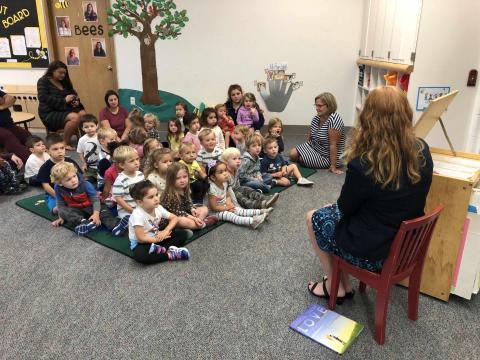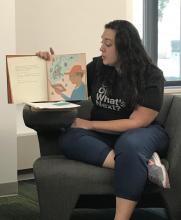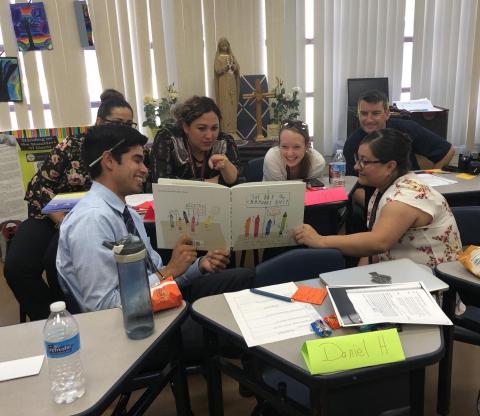The Power of Read Alouds // How to Perform an Effective Interactive Read Aloud
Interested in learning more about read alouds? Check out the "We Are All Readers and Writers" book talks!
 As a teacher, I have always loved reading aloud to my students, no matter what grade level I was teaching. I have done read alouds for second graders, middle schoolers, undergraduates, graduate students, and even principals. Storytelling is a fundamental aspect of our community and humanity. Christ, our greatest teacher, knew well the power of story to instruct. The act of reading aloud makes text come alive and produces its own kind of magic.
As a teacher, I have always loved reading aloud to my students, no matter what grade level I was teaching. I have done read alouds for second graders, middle schoolers, undergraduates, graduate students, and even principals. Storytelling is a fundamental aspect of our community and humanity. Christ, our greatest teacher, knew well the power of story to instruct. The act of reading aloud makes text come alive and produces its own kind of magic.
As a mom, I couldn't wait to read aloud to our daughter. I started reading aloud as soon as I found out as I was pregnant. Now that our daughter is three, every night she chooses the book she wants us to read to her from her bookshelf and if it's one that we've read a lot, she can "read" it back to us. Goldilocks and the Three Bears and Mixed: A Colorful Story are current favorites that she can recite by heart.
 Teachers have been reading aloud to students for years and the research base on the power of read alouds is extensive and well documented. Research has shown that read alouds improve comprehension (Duke & Pearson, 2008), vocabulary (Massaro, 2017), and fluency (Trelease, 2001). Read alouds allow the teacher to model expert, fluent reading of the text. This liberates the students from having to do the work of decoding and allows them to focus on comprehension, acquisition of new vocabulary, phonemic awareness, etc. For this reason, teachers can select books that are above students' independent reading level but at their listening level. According to Massaro, "children listening to a reading aloud of a picture book are roughly three times more likely to experience a new word type that is not among the most frequent words in the child's language" (2017, p. 64). This is particularly important in early elementary classrooms to ensure that children become familiar with a wider range of words earlier in life, knowing that children come to school with varying levels of exposure to more complex vocabulary.
Teachers have been reading aloud to students for years and the research base on the power of read alouds is extensive and well documented. Research has shown that read alouds improve comprehension (Duke & Pearson, 2008), vocabulary (Massaro, 2017), and fluency (Trelease, 2001). Read alouds allow the teacher to model expert, fluent reading of the text. This liberates the students from having to do the work of decoding and allows them to focus on comprehension, acquisition of new vocabulary, phonemic awareness, etc. For this reason, teachers can select books that are above students' independent reading level but at their listening level. According to Massaro, "children listening to a reading aloud of a picture book are roughly three times more likely to experience a new word type that is not among the most frequent words in the child's language" (2017, p. 64). This is particularly important in early elementary classrooms to ensure that children become familiar with a wider range of words earlier in life, knowing that children come to school with varying levels of exposure to more complex vocabulary.
Read alouds also give children experience with decontextualized language–requiring students to make sense of ideas beyond the classroom and the here and now (see Beck & McKeown, 2001). A key aspect of this sense-making is the role of dialogue. Students need to engage in discussion with their teacher and classmates to make sense of the text. This emphasis on talk highlights the importance of careful planning of think alouds and questions.
To be truly powerful and magical, the practice of reading aloud is actually quite complex. The following steps are crucial to enacting a powerful classroom read aloud.

1. Set the stage

There is an artfulness to a good read aloud. Setting the stage is important. Consider where and how you will sit to make sure all students can see the book. Think about how you can create a sense of comfort and community so that students feel that read-aloud time is a sacred, ritual part of your classroom culture. Also, consider how you want students to sit in order to minimize distractions and maximize their focus on the book.
2. Plan to read aloud
The key to a successful and powerful read-aloud is careful, deliberate planning. The first step in planning is selecting what to read. Here are some tips for selecting great read-aloud books: 
- For emergent, early readers, choose books with powerful illustrations. These not only keep students' attention but also act as scaffolds to help students understand the text.
- Expose students to a variety of genres. We all love reading great picture books with students. However, students also benefit from read alouds of informational text, chapter books, humor, etc.
- Use books that develop specific literacy skills such as alphabet books, rhymes, sounds, phonemic awareness, and books that are rich in new vocabulary.
- Choose books that serve as models for writing
- Choose books that offer opportunities for new learning (new vocabulary, new concepts, new ways of thinking)
- Choose books that lead to conversation so that students will have lots to talk and write about after the read aloud
- Choose books from recommended book lists of high-quality literature
- Choose diverse books that reflect the beauty and diversity of our global world

3. Establish a clear purpose
One of the most difficult aspects of planning and executing a read-aloud is focusing in on a single purpose for your read aloud. You can re-read the same book many times for different purposes. Being clear about your purpose will help guide decisions such as which questions you will ask, what think alouds you will plan, and how often you will stop to engage students in the story.
4. Practice before class
Remember, one of the most important goals of a read-aloud is to model fluent reading. Yet, many teachers choose books to read aloud without practicing and as a result, mispronounce names or words, stumble, make mistakes, and are caught off guard by unexpected events in the story (Fisher, Flood, Lapp, & Frey, 2004). Use Post-it notes to plan questions, think alouds, and identify key vocabulary you want to define as you read (see Shedd & Duke, 2008 for additional tips on planning). Use a specific planning template related to your purpose (phonics, vocabulary, comprehension). Find a partner to read with and get feedback before reading to your class. This will help ensure that you can read the book, not just with fluency, but also with animation and expression.

During the read-aloud, be sure to start by explicitly sharing the purpose with students. For example, "We are going to learn new words from our story. Good readers learn as many words as possible so they can understand the story. After we learn new words, you can use them when you speak and write"(Taylor, 2011, p. 36).
5. Make it interactive!
A good read-aloud is interactive. Involve students in the story by asking them the open-ended questions you prepared, modeling your thinking, asking them to identify letters or words they know, clapping or putting their thumbs up when they hear a special word or a rhyme. Provide quick definitions or synonyms of unfamiliar words that might get in the way of students' comprehending the story.

6. Extending the read aloud
After the read aloud, consider how you can build on this modeling as you release students to guided or independent practice. For example, if your focus was on vocabulary, re-read the pages in the book that had your focus words. Have students repeat the words and engage in examples and non-examples of that word beyond the context of the story. Have the students try to use these new words in their own writing in response to the text. Extending the read-aloud will help avoid what Fisher et al. refer to as "channel surfing...it's like watching a TV when you don't control the remote. Things are happening, but they switch rapidly and don't seem to relate to one another" (2004, p. 14).
As we prepare to celebrate World Read Aloud Day on February 1st, I hope these tips help you plan and execute your best read aloud yet!
Happy Reading!

